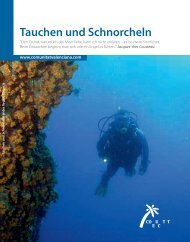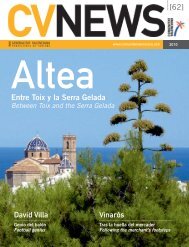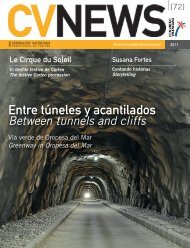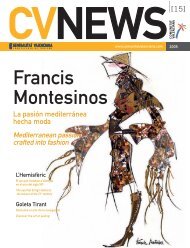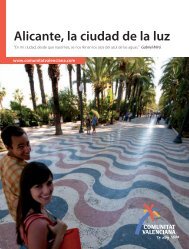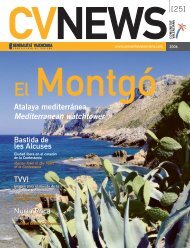Along the greenways of Xixarra, Serpis and La Safor: from the Serra ...
Along the greenways of Xixarra, Serpis and La Safor: from the Serra ...
Along the greenways of Xixarra, Serpis and La Safor: from the Serra ...
Create successful ePaper yourself
Turn your PDF publications into a flip-book with our unique Google optimized e-Paper software.
<strong>Along</strong> <strong>the</strong> <strong>greenways</strong> <strong>of</strong> <strong>Xixarra</strong>,<br />
<strong>Serpis</strong> <strong>and</strong> <strong>La</strong> <strong>Safor</strong>: <strong>from</strong> <strong>the</strong> <strong>Serra</strong><br />
Mariola to <strong>the</strong> Sea<br />
T his route makes use <strong>of</strong> three <strong>greenways</strong><br />
that run peacefully through some <strong>of</strong> <strong>the</strong><br />
quietest <strong>and</strong> least-known areas <strong>of</strong> <strong>the</strong> Region <strong>of</strong><br />
Valencia - L’Alt Vinalopó <strong>and</strong> El Comtat.<br />
The first <strong>of</strong> <strong>the</strong>se <strong>greenways</strong> runs along <strong>the</strong><br />
The <strong>Xixarra</strong> greenway between Villena <strong>and</strong> Beneixama<br />
disused narrow-gauge railway between Yecla<br />
<strong>and</strong> Muro de Alcoy <strong>and</strong> is known by <strong>the</strong> locals<br />
as El <strong>Xixarra</strong>. High spots <strong>of</strong> <strong>the</strong> route include<br />
From Villena to Oliva, visiting<br />
Biar, El Camp de<br />
Mirra, Beneixama,<br />
Fontanars dels Alforins,<br />
Banyeres de Mariola,<br />
Bocairent, Ontinyent,<br />
Albaida, Alfafara, Agres,<br />
Muro de Alcoy, Gaianes,<br />
Beniarrés, l’Orxa,<br />
Villalonga, Potríes,<br />
Beniarjó, Almoines <strong>and</strong><br />
G<strong>and</strong>ia.<br />
Route 10<br />
<strong>the</strong> source <strong>of</strong> <strong>the</strong> River Vinalopó in <strong>the</strong> very<br />
heart <strong>of</strong> <strong>the</strong> Parque Natural de la <strong>Serra</strong> Mariola<br />
nature park, as well as some <strong>of</strong> <strong>the</strong> most<br />
impressive castles in <strong>the</strong> Region <strong>of</strong> Valencia<br />
<strong>and</strong> <strong>the</strong> extraordinary mediaeval quarter <strong>of</strong><br />
Bocairent.<br />
The second greenway runs along <strong>the</strong> disused<br />
narrow-gauge line connecting Muro de<br />
Alcoy with el Grao de G<strong>and</strong>ia; popularly<br />
known as <strong>the</strong> train dels anglesos or “English<br />
Train”. It was used between 1893 <strong>and</strong> 1969 to<br />
carry coal <strong>from</strong> <strong>the</strong> port <strong>of</strong> G<strong>and</strong>ia to factories<br />
in Alcoy. This is a pleasant 28 mile route, <strong>and</strong><br />
not just because it’s fairly level <strong>and</strong> runs downhill,<br />
but also because it gives you <strong>the</strong> chance to<br />
see several natural areas <strong>of</strong> exceptional beauty<br />
as regards environment <strong>and</strong> l<strong>and</strong>scape: <strong>the</strong><br />
Parque Natural de la <strong>Serra</strong> Mariola, <strong>the</strong> Sierra<br />
del Benicadell, <strong>the</strong> Embalse de Beniarrés, <strong>the</strong><br />
Barranco de la Encantada, <strong>the</strong> Rincón del Duc,<br />
<strong>the</strong> Circo de la <strong>Safor</strong>, <strong>the</strong> Macizo del Mondúber<br />
<strong>and</strong> <strong>the</strong> Marjal de Pego-Oliva.<br />
The third greenway is ano<strong>the</strong>r disused railway<br />
line, known as <strong>La</strong> <strong>Safor</strong> <strong>and</strong> connecting<br />
117
You start at <strong>the</strong> Santuario de <strong>La</strong>s Virtudes in<br />
Villena. From this sanctuary, you travel to<br />
Villena along a recently opened stretch that<br />
is completely flat <strong>and</strong> an easy ride for<br />
anybody. The 4.5 miles to Villena give you<br />
<strong>the</strong> chance to see some <strong>of</strong> <strong>the</strong> ancient<br />
saltings, still in use today, with <strong>the</strong> white<br />
pyramids <strong>of</strong> salt cutting into <strong>the</strong> blue sky -<br />
perhaps <strong>the</strong> image that most visitors will<br />
remember <strong>of</strong> this part <strong>of</strong> <strong>the</strong> journey.<br />
The Villena saltings are located on flat<br />
l<strong>and</strong> with no surface run-<strong>of</strong>f, known technically<br />
as an endhorreic zone. Many <strong>of</strong> <strong>the</strong>m<br />
have dried out <strong>and</strong> are now used to grow<br />
such vegetables as carrots <strong>and</strong> seasonal fruit<br />
like melons, while some <strong>of</strong> <strong>the</strong> smallholdings<br />
produce ecological crops. A stroll<br />
118<br />
Route 10<br />
G<strong>and</strong>ia with Oliva along <strong>the</strong> old tracks<br />
between Carcaixent <strong>and</strong> Dénia, a pleasant walk<br />
or ride through a patchwork <strong>of</strong> citrus orchards.<br />
Let's take a look at <strong>the</strong> route<br />
From Villena to Bocairent along <strong>the</strong><br />
El <strong>Xixarra</strong> greenway<br />
Traditional olive fields between Villena <strong>and</strong> Biar<br />
through this area can be very rewarding,<br />
letting you enjoy open l<strong>and</strong>scapes with <strong>the</strong><br />
occasional small hills, known locally as<br />
cabezos, for example El Cabezo de la Virgen<br />
near Villena, where you started your trip.<br />
In Villena, you mustn’t miss <strong>the</strong><br />
impressive castle, founded by <strong>the</strong> Arabs <strong>and</strong><br />
transformed in succeeding centuries before<br />
being painstakingly restored in <strong>the</strong> 20 th<br />
century.<br />
Highlights <strong>of</strong> your tour around Villena<br />
will include <strong>the</strong> Iglesia de Santiago <strong>and</strong> <strong>the</strong><br />
Municipal Archaeological Museum containing<br />
El Tesoro de Villena - an amazing treasure<br />
consisting <strong>of</strong> 66 mostly gold items, including<br />
bracelets, bowls <strong>and</strong> jars.<br />
The next stop is Biar, whose castle has<br />
been declared a Site <strong>of</strong> Cultural Interest.<br />
Take a relaxing stroll <strong>and</strong> enjoy <strong>the</strong> amazing<br />
historical heritage stretched out below <strong>the</strong><br />
castle: <strong>the</strong> old quarter, <strong>the</strong> Ethnographic<br />
Museum, <strong>the</strong> hermitages, sanctuary <strong>and</strong><br />
aqueduct, etc.<br />
Shortly afterwards, you come to<br />
Campo de Mirra, where only a single<br />
tower remains <strong>of</strong> <strong>the</strong> famous Castillo de<br />
Almizra. This was where <strong>the</strong> Tratado de
Almizra was signed between King Alfonso X<br />
El Sabio <strong>of</strong> Castile <strong>and</strong> Jaime I <strong>of</strong> Aragón in<br />
1244. This treaty set out <strong>the</strong> boundaries <strong>of</strong><br />
<strong>the</strong>ir respective kingdoms <strong>and</strong> for centuries<br />
<strong>the</strong>y were a source <strong>of</strong> friction between <strong>the</strong><br />
later kingdoms <strong>of</strong> Castile, Murcia <strong>and</strong><br />
Valencia. This is why <strong>the</strong>re are so many<br />
powerful <strong>and</strong> substantial castles in <strong>the</strong><br />
Vinalopó area, especially those <strong>of</strong> Banyeres<br />
de Mariola, Biar, Villena, Castalla, Sax<br />
<strong>and</strong> Petrer.<br />
From sleepy Beneixama, you take <strong>the</strong><br />
CV-657 minor road over <strong>the</strong> Sierra de la<br />
Solana mountains to Fontanars dels<br />
Alforins, set on a beautiful plain known as<br />
<strong>the</strong> Tuscany <strong>of</strong> Valencia <strong>and</strong> closed <strong>of</strong>f to <strong>the</strong><br />
north by <strong>the</strong> Sierra Grossa. The Dels<br />
Alforins area is a unique, well-balanced rural<br />
l<strong>and</strong>scape with vineyards <strong>and</strong> cereal crops<br />
set among pines <strong>and</strong> Holm oaks.<br />
Back in Beneixama, <strong>the</strong> countryside<br />
largely consists <strong>of</strong> orchards, vineyards,<br />
almond <strong>and</strong> olive trees. The quiet Arab<br />
streets conceal <strong>the</strong> 18 th<br />
century Neoclassical<br />
church, Iglesia de San Juan Bautista, <strong>the</strong><br />
Atalaya <strong>and</strong> Negret towers (built in Muslim<br />
times) <strong>and</strong> also <strong>the</strong> Ermita de la Virgen de la<br />
Aurora hermitage.<br />
On <strong>the</strong> way back <strong>from</strong> Fontanars dels<br />
Alforins, <strong>the</strong> delights <strong>of</strong> <strong>the</strong> Sierra Solana<br />
include a snow store <strong>and</strong> <strong>the</strong> Duenya,Talaeta<br />
<strong>and</strong> Rita springs.<br />
The Beneixama section <strong>of</strong> <strong>the</strong> greenway<br />
runs through beautiful pinewoods beside <strong>the</strong><br />
waters <strong>of</strong> <strong>the</strong> River Vinalopó. You can ford<br />
<strong>the</strong> river, taking care as you climb down one<br />
side <strong>and</strong> up <strong>the</strong> opposite bank <strong>of</strong> <strong>the</strong> river.<br />
You should visit <strong>the</strong> old quarter <strong>of</strong><br />
Banyeres de Mariola, if only for its terraces<br />
<strong>and</strong> <strong>the</strong> impressive castle on top <strong>of</strong> a<br />
<strong>Along</strong> <strong>the</strong> <strong>greenways</strong> <strong>of</strong> <strong>Xixarra</strong>, <strong>Serpis</strong> <strong>and</strong> <strong>La</strong> <strong>Safor</strong>:<br />
<strong>from</strong> <strong>the</strong> <strong>Serra</strong> Mariola to <strong>the</strong> Sea<br />
hill that is crowned with snow every winter.<br />
However, Banyeres has even more<br />
treausures, such as <strong>the</strong> Museu Valencià del<br />
Paper. This museum recreates <strong>the</strong> role<br />
played by paper in <strong>the</strong> world <strong>and</strong> <strong>the</strong> Region<br />
<strong>of</strong> Valencia, with various displays that make<br />
it a living place where you <strong>the</strong> visitor can<br />
experience papermaking at first h<strong>and</strong>.<br />
Back on <strong>the</strong> route, you come to <strong>the</strong><br />
Ermita de San Antonio de Padua, a pretty<br />
spot with a surprisingly large traditional irrigation<br />
reservoir that fits in perfectly with its<br />
traditional rural setting. Shortly afterwards,<br />
<strong>the</strong> greenway reaches Bocairent along a<br />
lane parallel to <strong>the</strong> road that runs past an<br />
important cross marking <strong>the</strong> town limits.<br />
Bocairent has an important cultural<br />
heritage <strong>and</strong> you ought to visit <strong>the</strong> mediaeval<br />
quarter, Les Covetes dels Moros hanging <strong>from</strong> a<br />
rocky outcrop, <strong>the</strong> famous bullring carved<br />
out <strong>of</strong> <strong>the</strong> living rock, <strong>the</strong> parish museum<br />
<strong>and</strong> <strong>the</strong> Sant Blai snow store. There are also<br />
5 hermitages <strong>and</strong> a bell tower that is said to<br />
be <strong>the</strong> tallest in <strong>the</strong> Region <strong>of</strong> Valencia.<br />
From Bocairent to Muro de Alcoy,<br />
beneath <strong>the</strong> <strong>Serra</strong> Mariola<br />
From Bocairent, it’s worth visiting <strong>the</strong><br />
nearby towns <strong>of</strong> Ontinyent <strong>and</strong> Albaida. This<br />
alternative route takes <strong>the</strong> CV-81 <strong>and</strong> CV-40<br />
minor roads, leaving <strong>the</strong> greenway between<br />
Bocairent <strong>and</strong> Muro de Alcoy.<br />
Before you reach Ontinyent itself you’ll<br />
find <strong>the</strong> crystal-clear waters <strong>of</strong> Pou Clar, one<br />
<strong>of</strong> <strong>the</strong> most famous pools in <strong>the</strong> mountains <strong>of</strong><br />
inl<strong>and</strong> Valencia.<br />
Once in Ontinyent, don’t miss <strong>the</strong><br />
chance to w<strong>and</strong>er around <strong>the</strong> mediaeval<br />
quarter, with <strong>the</strong> splendid Iglesia de Santa<br />
119
María. Work on this church started in <strong>the</strong><br />
13 th<br />
century - apparently on top <strong>of</strong> an old<br />
mosque, but wasn’t finished until <strong>the</strong> 14 th<br />
<strong>and</strong> 15 th<br />
centuries, providing us with one <strong>of</strong><br />
<strong>the</strong> few examples <strong>of</strong> Primitive Valencian<br />
Gothic architecture. The height <strong>of</strong> its bell<br />
tower rivals that <strong>of</strong> Bocairent. Also worth a<br />
visit are <strong>the</strong> Town Hall, <strong>the</strong> Torre del Puente,<br />
<strong>the</strong> Iglesia de Sant Miquel, <strong>the</strong> Portal de Sant<br />
Roc <strong>and</strong> El Pont Vell.<br />
Take <strong>the</strong> dual carriageway <strong>from</strong><br />
Ontinyent to Albaida. Of special interest<br />
in this town is <strong>the</strong> Palacio de los Marqueses<br />
de Albaida, los Mira y Aragó. The palace<br />
houses one <strong>of</strong> <strong>the</strong> most original museums in<br />
<strong>the</strong> Region <strong>of</strong> Valencia - El Museu<br />
Internacional de Titelles puppet museum.<br />
You can also visit <strong>the</strong> Casa-Museo José<br />
Segrelles next to <strong>the</strong> palace. Just as interesting<br />
is a visit to late 16 th<br />
century Iglesia<br />
Arciprestal de Santa María, a stern Gothic<br />
building with an original bell tower.<br />
You rejoin <strong>the</strong> El <strong>Xixarra</strong> greenway<br />
between Bocairent <strong>and</strong> Muro, where it runs<br />
along a valley known as <strong>La</strong> Valleta d’Agres, a<br />
little-known area <strong>of</strong> transition usually<br />
passed through by occasional visitors <strong>and</strong><br />
day-trippers on <strong>the</strong>ir way to <strong>the</strong> Parque<br />
Natural de la <strong>Serra</strong> Mariola <strong>and</strong> <strong>the</strong> village<br />
<strong>of</strong> Agres at its foot.<br />
The l<strong>and</strong>scape <strong>of</strong> this valley exudes<br />
visual harmony <strong>and</strong> <strong>the</strong> environment<br />
respects <strong>the</strong> traditional agricultural l<strong>and</strong>scapes<br />
around Agres. As it has been isolated<br />
both socially <strong>and</strong> economically, this l<strong>and</strong>scape<br />
is still based on <strong>the</strong> primary sector,<br />
meaning that what you see today is almost<br />
<strong>the</strong> same as what <strong>the</strong> botanist Cavanilles<br />
described in <strong>the</strong> late 18 th<br />
century: “They’ve<br />
cultivated almost all <strong>the</strong> l<strong>and</strong> <strong>the</strong>y can:<br />
120<br />
Route 10<br />
<strong>the</strong>re are vines on <strong>the</strong> slopes, wheat <strong>and</strong><br />
barley on <strong>the</strong> flat l<strong>and</strong> <strong>and</strong> vegetable plots<br />
in those areas that can be irrigated, areas<br />
that are increasing every day as <strong>the</strong>y dig up<br />
<strong>the</strong> slopes <strong>of</strong> Mariola.To make things easier<br />
<strong>the</strong>y have levelled <strong>the</strong> fields, terraced <strong>the</strong><br />
slopes <strong>and</strong> fixed <strong>the</strong> banks...”<br />
In this privileged area, you’ll find,<br />
close to <strong>the</strong> greenway, masías like El Pinet,<br />
a fortified farmstead with battlements<br />
almost 200 years old, nestling among<br />
hundred-year-old pines, Holm oaks <strong>and</strong><br />
cypresses <strong>and</strong> currently <strong>of</strong>fering B & B.<br />
Like El Pinet, <strong>the</strong> farmsteads in <strong>the</strong> area<br />
were <strong>the</strong> st<strong>and</strong>ard farming units, basically<br />
exploiting unirrigated l<strong>and</strong> up to just 50<br />
years ago.They included <strong>the</strong> day labourer’s<br />
house <strong>and</strong> <strong>the</strong> owner’s summer residence,<br />
as well as auxiliary farm buildings.<br />
Chronologically speaking, most <strong>of</strong> <strong>the</strong>se<br />
buildings were built between <strong>the</strong> late 18 th<br />
<strong>and</strong> early 20 th<br />
centuries.<br />
Especially interesting in <strong>the</strong> section<br />
between Bocairent <strong>and</strong> Muro de Alcoy are<br />
<strong>the</strong> villages <strong>of</strong> Alfafara <strong>and</strong> Agres, with Arab<br />
street plans that create a world on a human<br />
scale on <strong>the</strong> nor<strong>the</strong>rn slopes <strong>of</strong> <strong>the</strong> Parque<br />
Natural de la <strong>Serra</strong> Mariola.<br />
In Alfafara, spend some time visiting<br />
<strong>the</strong> maze <strong>of</strong> uneven streets with small Arab<br />
squares, <strong>the</strong> 18 th<br />
century parish church <strong>and</strong><br />
<strong>the</strong> ancient washhouse - still in use today.<br />
Famous sights in <strong>the</strong> area include <strong>La</strong>s<br />
Coves de les Finestres, <strong>the</strong> remains <strong>of</strong> <strong>the</strong> walls<br />
<strong>of</strong> <strong>the</strong> Iberian settlement on <strong>the</strong> summit <strong>of</strong><br />
<strong>the</strong> Mariola mountains, <strong>the</strong> Cava de Sant<br />
Miquel <strong>and</strong> <strong>the</strong> Cava del Portín, two spectacular<br />
snow stores, especially <strong>the</strong> former.<br />
Also surprising is <strong>the</strong> Cueva de la Font ravine,<br />
<strong>the</strong> El Tarragó <strong>and</strong> L’Assut springs, <strong>the</strong>
pinewoods <strong>of</strong> <strong>La</strong> Vila, <strong>the</strong> cave <strong>of</strong> El<br />
Bolumini <strong>and</strong> <strong>the</strong> Ermita de Sant Antoni<br />
y Carbonell.<br />
Agres is in a spectacular location,<br />
cascading down <strong>the</strong> slopes <strong>of</strong> <strong>the</strong> Parque<br />
Natural de la <strong>Serra</strong> Mariola. Interesting<br />
features <strong>of</strong> this town with Arab roots are<br />
<strong>the</strong> parish church <strong>and</strong> <strong>the</strong> many welcome<br />
drinking fountains <strong>and</strong> springs.<br />
On <strong>the</strong> road to <strong>La</strong> <strong>Serra</strong> Mariola, visit<br />
<strong>the</strong> site <strong>of</strong> <strong>the</strong> ancient Arab castle, <strong>the</strong><br />
Franciscan convent where legend has it that<br />
an image <strong>of</strong> <strong>the</strong> Virgin fleeing a fire in <strong>the</strong><br />
city <strong>of</strong> Alicante miraculously appeared on<br />
August 31 st<br />
1484, <strong>and</strong> <strong>the</strong> 16 th<br />
sanctuary <strong>of</strong><br />
<strong>La</strong> Mare de Déu del Castell.<br />
From Agres, a forest track <strong>of</strong>fers a beautiful<br />
way to enter <strong>the</strong> very heart <strong>of</strong> <strong>the</strong><br />
Parque Natural de la <strong>Serra</strong> Mariola. Once<br />
<strong>the</strong>re, you’ll find spectacular snow stores<br />
such as <strong>La</strong> Cava Arquejada, ancient yew<br />
trees <strong>and</strong> <strong>the</strong> chance to make your way<br />
through <strong>the</strong> myriad aromatic <strong>and</strong> medicinal<br />
plants to <strong>the</strong> ceiling <strong>of</strong> <strong>the</strong> nature park - El<br />
Montcabrer, 4,574 feet high <strong>and</strong> <strong>of</strong>fering<br />
fantastic views over sou<strong>the</strong>rn Valencia.<br />
The <strong>Serra</strong> Mariola is one <strong>of</strong> <strong>the</strong> bestloved<br />
mountains in <strong>the</strong> Region <strong>of</strong> Valencia<br />
<strong>and</strong> a favourite spot for a day out. The protected<br />
area <strong>of</strong> <strong>the</strong> mountains is perfectly<br />
signposted <strong>and</strong> well-defined, as it is a pronounced<br />
anticline that soars above <strong>the</strong><br />
neighbouring valleys. It quickly climbs to<br />
2,954 feet in <strong>the</strong> east <strong>and</strong> <strong>the</strong> silhouette <strong>of</strong><br />
its impregnable walls is impossible to confuse<br />
with any <strong>of</strong> <strong>the</strong> neighbouring mountains.<br />
El Montcabrer is <strong>the</strong> summit <strong>of</strong> <strong>the</strong><br />
<strong>Serra</strong> Mariola - an immense spur <strong>of</strong> rock<br />
that can be seen <strong>from</strong> much <strong>of</strong> Valencia, as<br />
if superimposed on <strong>the</strong> mountain range<br />
<strong>Along</strong> <strong>the</strong> <strong>greenways</strong> <strong>of</strong> <strong>Xixarra</strong>, <strong>Serpis</strong> <strong>and</strong> <strong>La</strong> <strong>Safor</strong>:<br />
<strong>from</strong> <strong>the</strong> <strong>Serra</strong> Mariola to <strong>the</strong> Sea<br />
itself. It soars to 4,574 feet <strong>and</strong> is abruptly<br />
cut across a great tectonic fault to <strong>the</strong> east.<br />
In <strong>the</strong> <strong>Serra</strong> Mariola, <strong>the</strong> height <strong>and</strong> its<br />
orientation condition <strong>the</strong> rainfall, especially<br />
because <strong>the</strong> east winds loaded with humidity<br />
reach <strong>the</strong> mountains to deposit this vital<br />
element, sometimes in violent storms <strong>and</strong><br />
sometimes as snow. These special conditions,<br />
combined with <strong>the</strong> predominance<br />
<strong>of</strong> limestone, make <strong>the</strong> mountains a great<br />
aljibe or cistern that collects <strong>the</strong> water <strong>and</strong><br />
The River <strong>Serpis</strong> in El Comtat<br />
distribute it through <strong>the</strong> springs <strong>and</strong><br />
streams on all its slopes. The most important<br />
rivers <strong>of</strong> nor<strong>the</strong>rn Alicante have <strong>the</strong>ir<br />
sources in <strong>the</strong> heart <strong>of</strong> <strong>the</strong>se mountains - El<br />
Vinalopó, El <strong>Serpis</strong>, El Agres <strong>and</strong> El<br />
Clariano.<br />
Much more snow fell a couple <strong>of</strong><br />
centuries ago, pro<strong>of</strong> <strong>of</strong> which lies in <strong>the</strong><br />
many neveras or snow stores scattered all<br />
over <strong>the</strong> mountains.<br />
This was especially so during <strong>the</strong> period<br />
known as <strong>the</strong> “Little Ice Age” that took place<br />
between <strong>the</strong> 17 th<br />
<strong>and</strong> 18 th<br />
centuries when<br />
121
most <strong>of</strong> <strong>the</strong> famous storehouses destined for<br />
<strong>the</strong> snow <strong>and</strong> ice trade were built.<br />
Above all, Mariola is known for <strong>the</strong><br />
great variety <strong>of</strong> different plant species that<br />
can be found <strong>the</strong>re: sage, rosemary, thyme,<br />
juniper, pennyroyal, etc., all ga<strong>the</strong>red for<br />
centuries as medicinal herbs.<br />
If you decide to drive <strong>from</strong> Villena to<br />
Muro de Alcoy, take <strong>the</strong> CV-81 minor road<br />
to Bocairent <strong>and</strong> <strong>the</strong>n <strong>the</strong> CV-700 minor<br />
road to Muro.<br />
The old quarter <strong>of</strong> Muro de Alcoy is<br />
exceptional, dominated by <strong>the</strong> parish church<br />
<strong>of</strong> Sant Joan Baptista, <strong>the</strong> hermitages <strong>of</strong> Sant<br />
Antoni <strong>and</strong> <strong>La</strong> Mare de Déu dels<br />
Desemparats, as well as a 17 th<br />
century<br />
mansion-palace. The old quarter also has<br />
several h<strong>and</strong>some noble houses <strong>and</strong> a<br />
general architectural style that gives <strong>the</strong><br />
town an air <strong>of</strong> distinction.<br />
122<br />
Route 10<br />
View <strong>of</strong> <strong>the</strong> Castillo de Villena<br />
From Muro de Alcoy to G<strong>and</strong>ia<br />
along <strong>the</strong> <strong>Serpis</strong> greenway<br />
From Muro to l’Orxa, you’ll travel along<br />
<strong>the</strong> foot <strong>of</strong> <strong>the</strong> Sierra del Benicadell, an<br />
impressive limestone mass 3,327 feet high.<br />
Its slopes are home to various indigenous<br />
plant species <strong>and</strong> it is also an important<br />
nesting ground for birds <strong>of</strong> prey.This mountain<br />
is <strong>of</strong> great cultural <strong>and</strong> anthropological<br />
value for <strong>the</strong> Valencian people. Especially<br />
interesting are <strong>the</strong> spectacular unirrigated<br />
terraces with <strong>the</strong>ir almond <strong>and</strong> olive trees,<br />
as well as <strong>the</strong> ever-stunning snow stores.<br />
Following <strong>the</strong> old English railway, today’s<br />
greenway passes through <strong>the</strong> noble village <strong>of</strong><br />
Gaianes, with its peaceful lifestyle. In<br />
Gaianes, <strong>the</strong> streets are on a human scale <strong>and</strong><br />
a few short steps take you to <strong>the</strong> 15 th<br />
century<br />
Iglesia de Sant Jaume. Take a pleasant<br />
stroll <strong>from</strong> <strong>the</strong> town to <strong>the</strong> beautiful Via<br />
Crucis <strong>and</strong> <strong>the</strong> Ermita de Sant Francesc de<br />
Paula, at <strong>the</strong> very base <strong>of</strong> <strong>the</strong> sheer cliffs <strong>of</strong><br />
El Benicadell.<br />
Shortly afterwards, you come to <strong>the</strong><br />
town <strong>of</strong> Beniarrés, <strong>from</strong> which a narrow<br />
road leads to Beniarrés reservoir, home to a<br />
wide range <strong>of</strong> fish <strong>and</strong> waterfowl.<br />
The nearby Barranco de la Encantada<br />
<strong>and</strong> its recreational area in one <strong>of</strong> <strong>the</strong> most<br />
spectacular <strong>and</strong> best-preserved ravines in<br />
<strong>the</strong> region.<br />
Beniarrés was conquered by King<br />
Jaime I <strong>and</strong> ceded to <strong>the</strong> Orden de Montesa<br />
- a religious order that was based in <strong>the</strong><br />
nearby Castillo de Perputxent. Here you<br />
should visit <strong>the</strong> town founded by <strong>the</strong><br />
Muslims, <strong>the</strong> 18 th<br />
century Iglesia de Sant<br />
Pere Apóstol <strong>and</strong> <strong>the</strong> nearby Ermita del Sant<br />
Crist, with its delightful Via Crucis. Near
town, you shouldn’t miss <strong>the</strong> Cueva de Els<br />
Nou Forats <strong>and</strong> <strong>the</strong> Cueva de l’Or - two<br />
caves with important archaeological<br />
remains.<br />
Return to <strong>the</strong> greenway <strong>and</strong> head along<br />
<strong>the</strong> clearly signposted track towards <strong>the</strong> old<br />
station <strong>of</strong> l’Orxa, <strong>from</strong> where <strong>the</strong>re are fantastic<br />
views <strong>of</strong> <strong>the</strong> Templar castle <strong>of</strong><br />
Perputxent, declared to be a Site <strong>of</strong> Cultural<br />
Interest. The station consists <strong>of</strong> several<br />
interesting old railway buildings <strong>and</strong> an<br />
ab<strong>and</strong>oned paper mill.<br />
From here, a lane forks <strong>of</strong>f to <strong>the</strong> village<br />
<strong>of</strong> l’Orxa, where you can enjoy <strong>the</strong> peace<br />
<strong>and</strong> quiet <strong>of</strong> <strong>the</strong> narrow streets huddled<br />
around <strong>the</strong> parish church.The village used to<br />
be called Perputxent, a name that refers to<br />
<strong>the</strong> valley where it nestles. A pact between<br />
King Jaime I <strong>and</strong> <strong>the</strong> Arab leader Al-Azraq<br />
allowed <strong>the</strong> latter to retain control <strong>of</strong><br />
l’Orxa, Benillup <strong>and</strong> Beniarrés. After <strong>the</strong><br />
defeat <strong>of</strong> <strong>the</strong> Muslim leader, <strong>the</strong> villages<br />
were controlled by <strong>the</strong> Templars, who held<br />
<strong>and</strong> enlarged <strong>the</strong> castle.<br />
Between l’Orxa <strong>and</strong> Villalonga, <strong>the</strong><br />
greenway runs along its most spectacular<br />
<strong>and</strong> audacious section, with an uninterrupted<br />
succession <strong>of</strong> cuttings, embankments<br />
<strong>and</strong> several tunnels - some <strong>of</strong> which are<br />
almost 350 yards long, running beside <strong>the</strong><br />
river. There are many surprises along this<br />
section <strong>of</strong> <strong>the</strong> route, including a spectacular<br />
azud - a channel <strong>and</strong> dam that collected<br />
water to supply <strong>the</strong> old hydroelectric power<br />
station. The power station building itself<br />
is quite charming, due both to its natural<br />
setting <strong>and</strong> its 19 th<br />
century architecture.<br />
Moving on, <strong>the</strong> next spot you come to is<br />
Racó del Duc, which, toge<strong>the</strong>r with <strong>the</strong><br />
cirque <strong>of</strong> <strong>La</strong> <strong>Safor</strong>, covers some 2,900<br />
<strong>Along</strong> <strong>the</strong> <strong>greenways</strong> <strong>of</strong> <strong>Xixarra</strong>, <strong>Serpis</strong> <strong>and</strong> <strong>La</strong> <strong>Safor</strong>:<br />
<strong>from</strong> <strong>the</strong> <strong>Serra</strong> Mariola to <strong>the</strong> Sea<br />
hectares. Between l’Orxa <strong>and</strong> Villalonga, <strong>the</strong><br />
River <strong>Serpis</strong> has carved out <strong>the</strong> spectacular<br />
gorge <strong>the</strong> greenway passes through along <strong>the</strong><br />
old railway line.You might well see birds <strong>of</strong><br />
prey, small carnivores <strong>and</strong> boars.<br />
The cirque <strong>of</strong> <strong>La</strong> <strong>Safor</strong> lies at a height <strong>of</strong><br />
over 3,280 feet <strong>and</strong> opens out towards <strong>the</strong><br />
coast. Don’t forget to climb <strong>the</strong> slopes <strong>of</strong><br />
this mythical mountain near Villalonga to<br />
enjoy <strong>the</strong> spectacular panoramic views <strong>of</strong><br />
<strong>the</strong> nearby coastline <strong>of</strong> <strong>La</strong> <strong>Safor</strong> <strong>from</strong> <strong>the</strong><br />
summit.<br />
Shortly before reaching Villalonga, stop at<br />
<strong>the</strong> <strong>La</strong> Reprimala drinking fountain with its<br />
16 spouts. The water is good to drink at this<br />
very popular spot near <strong>the</strong> River <strong>Serpis</strong>.<br />
In Villalonga, take your time to visit <strong>the</strong><br />
Capilla de <strong>La</strong> Mare de Déu de la Font, <strong>the</strong><br />
Iglesia dels Sants Reis, <strong>the</strong> Ermita de Santa<br />
Bárbara <strong>and</strong> <strong>the</strong> Via Crucis. The village itself<br />
is quiet <strong>and</strong> pleasant - perfect for strolling<br />
around, with its narrow streets <strong>and</strong> peaceful<br />
squares.<br />
After Villalonga, <strong>the</strong> valley <strong>of</strong> <strong>the</strong> River<br />
<strong>Serpis</strong> widens to give way to irrigated farml<strong>and</strong>,<br />
smallholdings <strong>and</strong> a continuous succession<br />
<strong>of</strong> citrus orchards. The route to<br />
G<strong>and</strong>ia passes through Potríes, Beniarjó <strong>and</strong><br />
Almoines, <strong>and</strong> you can see <strong>the</strong> traditional<br />
farming methods <strong>and</strong> enjoy <strong>the</strong> mild climate<br />
<strong>of</strong> <strong>La</strong> <strong>Safor</strong> - one <strong>of</strong> <strong>the</strong> most charming areas<br />
in <strong>the</strong> whole <strong>of</strong> <strong>the</strong> Region <strong>of</strong> Valencia.<br />
However, before you get to G<strong>and</strong>ia, you<br />
pass through <strong>the</strong> village <strong>of</strong> Potríes, with its<br />
impressive house-town hall located in a<br />
noble 17th century building, <strong>the</strong> Iglesia de<br />
Los Sants Joans, originally built in <strong>the</strong> 16th century, with <strong>the</strong> improvements made to<br />
<strong>the</strong> Capilla de Sant Blas chapel in <strong>the</strong> 18 th<br />
<strong>and</strong> 19 th<br />
centuries, <strong>the</strong> Ermita del Crist de la<br />
123
Agonia <strong>and</strong> Ángel Domínguez’s pottery, not<br />
forgetting <strong>the</strong> Museo de la Alfarería pottery<br />
museum.<br />
Ausiàs March was born in Beniarjó<br />
when <strong>the</strong> village was just a farmstead. The<br />
church <strong>of</strong> Sant Joan Baptista is hemmed in<br />
by a network <strong>of</strong> narrow alleyways that make<br />
for an especially relaxing stroll around a<br />
village that has preserved its buildings’<br />
traditional, popular architecture very well.<br />
In Almoines, you really should visit<br />
<strong>the</strong> Lombard silk factory, housed in a magnificent<br />
building with large windows set<br />
behind 19 th<br />
century cast iron grilles, <strong>and</strong><br />
<strong>the</strong> Iglesia de Santiago Apóstol, also built<br />
in <strong>the</strong> 19 th<br />
century. This municipality<br />
st<strong>and</strong>s out for its well-preserved popular<br />
architecture <strong>and</strong> <strong>the</strong> serenity <strong>of</strong> its narrow<br />
alleyways.<br />
You cross <strong>the</strong> restored bridge that carried<br />
<strong>the</strong> old English railway into G<strong>and</strong>ia, capital<br />
<strong>of</strong> <strong>the</strong> <strong>La</strong> <strong>Safor</strong> area.<br />
Don’t miss <strong>the</strong> Palacio Ducal <strong>and</strong> <strong>the</strong><br />
Iglesia Colegiata, an elegant example <strong>of</strong> 14 th<br />
<strong>and</strong> 15 th<br />
century Gothic architecture that<br />
became a Collegiate Church in 1499 <strong>and</strong><br />
was declared a National Historic-Artistic<br />
Monument in 1931. Also <strong>of</strong> interest is <strong>the</strong><br />
18 th<br />
century Town Hall, <strong>of</strong> which only <strong>the</strong><br />
original facade remains, <strong>the</strong> Escuelas Pías -<br />
refurbished in <strong>the</strong> 16 th<br />
century, <strong>and</strong> <strong>the</strong><br />
Archaeological Museum (MAGA).<br />
<strong>La</strong> Calle Mayor - <strong>the</strong> town’s main<br />
street, runs through <strong>the</strong> old quarter, an area<br />
that is now <strong>the</strong> shopping <strong>and</strong> leisure centre<br />
<strong>of</strong> <strong>the</strong> town. The fact that it has been pedestrianised<br />
means that it is an exceptionally<br />
pleasant area.<br />
A visit to <strong>the</strong> Grao <strong>and</strong> beach at G<strong>and</strong>ia<br />
is always rewarding <strong>and</strong> allows you to enjoy<br />
124<br />
Route 10<br />
<strong>the</strong> fine, clean s<strong>and</strong> <strong>of</strong> a beautiful beach<br />
that is well cared for.<br />
You can drive <strong>from</strong> Muro de Alcoy to<br />
G<strong>and</strong>ia along <strong>the</strong> CV-705 minor road<br />
through Muro <strong>and</strong> Beniarrés, continuing to<br />
l’Orxa on <strong>the</strong> CV-701 minor road. From<br />
l’Orxa, a forest track goes around <strong>the</strong><br />
mountain containing <strong>the</strong> cirque <strong>of</strong> <strong>La</strong> <strong>Safor</strong><br />
to Villalonga, where you take <strong>the</strong> CV-685<br />
minor road to G<strong>and</strong>ia.<br />
Here are two suggestions to round <strong>of</strong>f<br />
your trip. To <strong>the</strong> north, you should visit <strong>La</strong><br />
Valldigna, a small, almost hidden valley<br />
with Arab roots that contains <strong>the</strong> Cistercian<br />
Monasterio de Santa María de la Valldigna<br />
in <strong>the</strong> village <strong>of</strong> Simat, lying at <strong>the</strong> foot <strong>of</strong><br />
<strong>the</strong> impressive El Mondúber massif.<br />
El Mondúber is an emblematic coastal<br />
mountain that rises 2,759 feet above <strong>the</strong><br />
waters <strong>of</strong> <strong>the</strong> Mediterranean. It’s one <strong>of</strong><br />
<strong>the</strong> most spectacular viewpoints along <strong>the</strong><br />
whole coast <strong>and</strong> its impressive crags contain<br />
caves such as those <strong>of</strong> Les Maravelles,<br />
El Parpalló <strong>and</strong> Les Rates Penades - all<br />
with a rich prehistoric past. To <strong>the</strong> south,<br />
close to Alfahuir <strong>and</strong> Rótova, you should<br />
also visit <strong>the</strong> imposing Monasterio de Sant<br />
Jeroni de Cotalba.<br />
The <strong>La</strong> <strong>Safor</strong> greenway heads southwards<br />
<strong>from</strong> G<strong>and</strong>ia to Oliva, nestling<br />
among a welcoming patchwork <strong>of</strong> orange<br />
groves <strong>and</strong> market gardens.Take <strong>the</strong> N-332<br />
A-road if you decide to drive.<br />
Reaching <strong>the</strong> end <strong>of</strong> <strong>the</strong> <strong>La</strong> <strong>Safor</strong><br />
greenway has as its reward <strong>the</strong> beaches <strong>of</strong><br />
Oliva <strong>and</strong> <strong>the</strong> Parque Natural de la Marjal<br />
de Pego-Oliva. Of all <strong>the</strong> marshes <strong>and</strong><br />
ancient lagoons that have appeared along<br />
this part <strong>of</strong> <strong>the</strong> coast, this nature park is<br />
<strong>the</strong> most striking <strong>of</strong> all those between <strong>the</strong>
mountain <strong>of</strong> Les Raboses in Cullera <strong>and</strong> El<br />
Montgó in Dénia.<br />
Its geomorphology <strong>and</strong> generous rainfall<br />
means that <strong>the</strong> Pego-Oliva marsh is <strong>the</strong><br />
heart <strong>of</strong> a very special coastal hydrological<br />
system. The River Bullent is said to be <strong>the</strong><br />
most plentiful <strong>of</strong> all <strong>the</strong> Valencian rivers, if<br />
you take into account <strong>the</strong> fact that it is very<br />
short, as it starts in <strong>the</strong> nature park itself,<br />
thanks to a number <strong>of</strong> springs in different<br />
parts <strong>of</strong> <strong>the</strong> Sierra de Mustalla.Water bubbles<br />
up <strong>from</strong> <strong>the</strong>se springs in abundance,<br />
not only because it rains a lot, but also<br />
because <strong>the</strong> calcareous rock <strong>of</strong> <strong>the</strong> mountains<br />
surrounding <strong>the</strong> marsh allows water<br />
to collect in <strong>the</strong> aquifers <strong>and</strong> <strong>the</strong> water<br />
table is almost at ground level. The plentiful<br />
precipitation means that <strong>the</strong> area is<br />
rich <strong>and</strong> generous with water <strong>of</strong> exceptional<br />
microbiological quality, appearing on <strong>the</strong><br />
surface as captivatingly beautiful sources<br />
<strong>and</strong> springs.<br />
Two abundant rivers, <strong>the</strong> Bullent <strong>and</strong><br />
<strong>the</strong> Molinell or Racons, break through <strong>the</strong><br />
coastal s<strong>and</strong>bar, providing natural drainage<br />
The River Bullent in <strong>the</strong> Pego-Oliva marsh<br />
<strong>Along</strong> <strong>the</strong> <strong>greenways</strong> <strong>of</strong> <strong>Xixarra</strong>, <strong>Serpis</strong> <strong>and</strong> <strong>La</strong> <strong>Safor</strong>:<br />
<strong>from</strong> <strong>the</strong> <strong>Serra</strong> Mariola to <strong>the</strong> Sea<br />
for <strong>the</strong> copious waters <strong>of</strong> <strong>the</strong> springs <strong>and</strong><br />
sources, thus maintaining <strong>the</strong> hydrological<br />
balance <strong>of</strong> <strong>the</strong> park.<br />
The cañaverales or reedbeds are surprising<br />
features <strong>of</strong> <strong>the</strong> deeper, flooded areas <strong>of</strong><br />
<strong>the</strong> park, with reeds <strong>and</strong> cat’s-tails rivalling<br />
to dominate <strong>the</strong> l<strong>and</strong>scape. However, <strong>the</strong><br />
star <strong>of</strong> <strong>the</strong> show as regards plant life in <strong>the</strong><br />
marsh waters is undoubtedly <strong>the</strong> yellow<br />
lily. The Pego-Oliva wetl<strong>and</strong>s are <strong>the</strong> best<br />
place in <strong>the</strong> whole Region <strong>of</strong> Valencia to<br />
take pleasure in <strong>the</strong>ir presence, especially<br />
when <strong>the</strong>y blossom in spring.<br />
The nature park is home to a wide variety<br />
<strong>of</strong> birds, <strong>the</strong> most interesting species<br />
being <strong>the</strong> lapwing <strong>and</strong> <strong>the</strong> fish eagle.You can<br />
also see reed buntings, crested grebes,<br />
whiskered terns, little bitterns, common<br />
redshanks, little ringed plovers, moustached<br />
warblers, black-winged stilts, little<br />
grebes, grey herons, purple herons - <strong>of</strong><br />
which 30 pairs have reproduced in <strong>the</strong> park,<br />
squacco herons <strong>and</strong> marbled teals.<br />
In <strong>the</strong> past, <strong>the</strong> Pego-Oliva marsh<br />
extended its cultural l<strong>and</strong>scape beyond<br />
125
what are strictly <strong>the</strong> wetl<strong>and</strong>s, as its most<br />
striking plants - reeds <strong>and</strong> cat’s-tails, were<br />
used in <strong>the</strong> 1960’s, <strong>and</strong> are still used today<br />
by some craftsmen to produce different<br />
objects <strong>and</strong> tools, such as <strong>the</strong> well-known<br />
brooms <strong>and</strong> cane tools used for different<br />
farm <strong>and</strong> household tasks.<br />
Inside <strong>the</strong> nature park near Oliva,<br />
you’ll find <strong>the</strong> Fuente Salada, one <strong>of</strong> <strong>the</strong><br />
nicest spots in <strong>the</strong> park <strong>and</strong> where medicinal<br />
waters come to <strong>the</strong> surface. This has<br />
been converted into an open-air spa since<br />
Oliva Town Council improved access to <strong>the</strong><br />
two springs <strong>and</strong> <strong>the</strong>ir surroundings.<br />
After visiting <strong>the</strong> Pego-Oliva marsh,<br />
stroll around Oliva itself, with its Arab<br />
quarter, <strong>the</strong> churches <strong>of</strong> Santa María <strong>and</strong><br />
Sant Roc, <strong>the</strong> Casa de Mayans <strong>and</strong> <strong>the</strong><br />
remains <strong>of</strong> <strong>the</strong> towers along <strong>the</strong> Arab walls<br />
<strong>of</strong> <strong>the</strong> ancient castle.<br />
126<br />
Route 10<br />
<strong>La</strong> Ermita de la Mare de Déu de la Luz between Alfafara <strong>and</strong> Agres<br />
Useful information<br />
Festivals,food <strong>and</strong> crafts<br />
Food <strong>and</strong> drink in <strong>the</strong> area along <strong>the</strong> El<br />
<strong>Xixarra</strong> greenway between Villena <strong>and</strong><br />
Muro is based on local produce, <strong>of</strong>fering<br />
such delicious dishes as <strong>the</strong> popular gazpacho<br />
manchego (a stew, <strong>of</strong>ten made with rabbit,<br />
hare, chicken or partridge), el ajotonto<br />
(potato, cod, garlic, parsley <strong>and</strong> olive oil),la<br />
gachamiga (peasant dish <strong>of</strong> flour, breadcrumbs<br />
<strong>and</strong> bacon), la pericana (peppers,<br />
salt cod, oil <strong>and</strong> garlic), la olla (stew with<br />
many variants - vegetables, meat, even slowly<br />
stewed fruit) , la bajoca farcida (peppers<br />
stuffed with rice, beans <strong>and</strong> loin <strong>of</strong> pork or<br />
tuna), las fassegures (meatballs made with<br />
flour, bacon <strong>and</strong> o<strong>the</strong>r ingredients according<br />
to each village), <strong>and</strong> el giraboix (stew with<br />
vegetables, cod, oil <strong>and</strong> water). This area<br />
produces excellent wines <strong>and</strong> delightful<br />
liqueurs that include herbero (herb liqueur)<br />
<strong>and</strong> café-licor (c<strong>of</strong>fee liqueur). Nor must we<br />
forget <strong>the</strong> delicious sweets, especially <strong>the</strong><br />
nueces azucaradas (sugared nuts), turrones
(nougat) <strong>and</strong> peladillas (sugared almonds).<br />
With regard to festivals, most <strong>of</strong> <strong>the</strong><br />
towns <strong>and</strong> villages along <strong>the</strong> route celebrate<br />
<strong>the</strong> popular Moors <strong>and</strong> Christians festivals,<br />
as well as famous processions to <strong>the</strong> many<br />
hermitages in <strong>the</strong> area.<br />
Around <strong>La</strong> <strong>Safor</strong>, you can give your<br />
palate a treat by trying dishes combining<br />
<strong>the</strong> local farm produce with seafood.<br />
Excellent examples are such dishes as la<br />
fideuà (noodles in fish stock), la gamba amb<br />
bleda (prawns <strong>and</strong> Swiss chard or spinach),<br />
not forgetting <strong>the</strong> ever-popular paella <strong>and</strong><br />
fish <strong>and</strong> shellfish fresh <strong>from</strong> <strong>the</strong><br />
Mediterranean.<br />
O<strong>the</strong>r festivals in <strong>the</strong> heart <strong>of</strong> <strong>the</strong> <strong>La</strong><br />
<strong>Safor</strong> region include <strong>the</strong> popular Fallas in<br />
March, as well as several festivals with a<br />
nautical flavour, not forgetting <strong>the</strong> patron<br />
saint festivals <strong>and</strong> fairs in <strong>the</strong> surrounding<br />
towns <strong>and</strong> villages.<br />
When to visit<br />
Any time <strong>of</strong> <strong>the</strong> year is a good time to go.<br />
From late January to mid-March, <strong>the</strong><br />
route is given an extra touch <strong>of</strong> colour by <strong>the</strong><br />
blossoming almond trees.<br />
During <strong>the</strong> autumn, <strong>the</strong> deciduous trees<br />
along <strong>the</strong> banks <strong>of</strong> <strong>the</strong> River <strong>Serpis</strong> take on a<br />
surprisingly wide range <strong>of</strong> colours.<br />
Public transport<br />
Regional trains run to <strong>and</strong> <strong>from</strong> Villena.<br />
Local trains run <strong>from</strong> G<strong>and</strong>ia back to<br />
Valencia. Bicycles are carried free <strong>of</strong> charge.<br />
Advice <strong>and</strong> recommendations<br />
If you want to enjoy <strong>the</strong> route as described<br />
by bike or on foot, please note <strong>the</strong><br />
following:<br />
<strong>Along</strong> <strong>the</strong> <strong>greenways</strong> <strong>of</strong> <strong>Xixarra</strong>, <strong>Serpis</strong> <strong>and</strong> <strong>La</strong> <strong>Safor</strong>:<br />
<strong>from</strong> <strong>the</strong> <strong>Serra</strong> Mariola to <strong>the</strong> Sea<br />
Use a mountain or at least a hybrid<br />
road-mountain bike.<br />
There aren’t many springs outside<br />
<strong>the</strong> towns, so stock up with water when<br />
you can.<br />
Dawn <strong>and</strong> dusk always have <strong>the</strong> best<br />
light <strong>and</strong> are <strong>the</strong> most pleasant times <strong>of</strong> day.<br />
You can use your car by replacing <strong>the</strong> <strong>greenways</strong><br />
for nearby roads. See <strong>the</strong> text for <strong>the</strong><br />
alternative road routes for each section.<br />
Maps recommended for this<br />
route:<br />
Instituto Geográfico Nacional. Scale 1:25.000,<br />
Sheet numbers: 740-I. 795-II, IV; 796-I; 820-II,<br />
III, IV; 821-I, II; 845-II <strong>and</strong> 846-I.<br />
127
www.comunitatvalenciana.com<br />
Communitat Valenciana Contact Centre:<br />
Tel. 902 12 32 12<br />
Tourist information <strong>of</strong>fices on this Route:<br />
Tourist Info Villena<br />
Pl. de Santiago 5 · 03400<br />
Villena<br />
Tel. 965 80 38 04 · Fax 965 80 37 06<br />
villena@touristinfo.net<br />
Tourist Info Bocairent<br />
Pl. del Ayuntamiento 2 · 46880<br />
Bocairent<br />
Tel. 962 90 50 62 · Fax 962 90 50 85<br />
bocairent@touristinfo.net<br />
Tourist Info Muro de Alcoy<br />
Pl. Matzem s/n · 03830<br />
Muro de Alcoy<br />
Tel. 965 53 20 71 · Fax 965 53 20 71<br />
muroalcoi@touristinfo.net<br />
Tourist Info G<strong>and</strong>ia<br />
Av. Marqués de Campo s/n · 46700<br />
G<strong>and</strong>ia<br />
Tel. 962 87 77 88 · Fax 962 86 55 77<br />
g<strong>and</strong>ia@touristinfo.net<br />
Regional <strong>and</strong> local train information:<br />
Renfe<br />
902 24 02 02<br />
www.renfe.es<br />
128<br />
Route 10<br />
For more information



